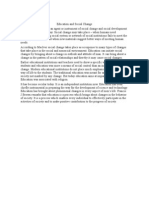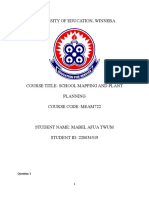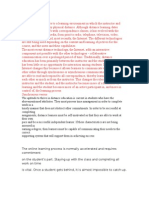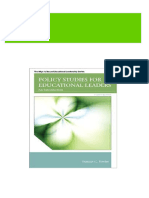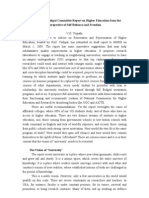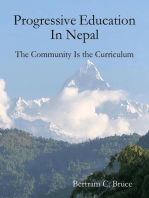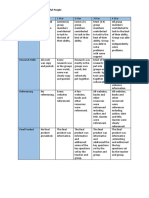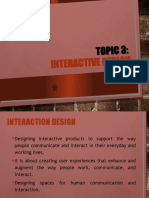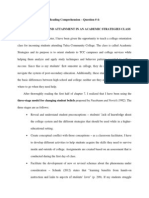Education Studies and System
Education Studies and System
Uploaded by
Mani Krishna SarkarCopyright:
Available Formats
Education Studies and System
Education Studies and System
Uploaded by
Mani Krishna SarkarOriginal Description:
Copyright
Available Formats
Share this document
Did you find this document useful?
Is this content inappropriate?
Copyright:
Available Formats
Education Studies and System
Education Studies and System
Uploaded by
Mani Krishna SarkarCopyright:
Available Formats
SEMESTER II
Paper CC5: Educational Studies and System
Unit-II Education as Interdisciplinary Knowledge
Interdisciplinary nature of education; relationships with disciplines and subjects such as
philosophy, psychology, sociology, management, economics, and anthropology.
Dynamic relationship of education with the social and political process.
Contribution of science and technology to education.
Issues related to planning, management and monitoring of education
Dear M.Ed. II SEM. students
Let us start the discussion with the first point:
Interdisciplinary nature of education
What is interdisciplinary study?
This type of study allows the student to learn by making connections between ideas and
concepts across different disciplinary boundaries. Students learning in this way are able to apply
the knowledge gained in one discipline to another different discipline as a way to deepen the
learning experience. The most effective approach to interdisciplinary study enables students to
build their own interdisciplinary pathway by choosing courses which make sense to them.
For example, it is not too difficult to find a theme which crosses over disciplinary
boundaries in literature, art and history or science and mathematics. Studying topics thematically
is one way to bring ideas together resulting in more meaningful learning. This can occur by
allowing students to choose their own subjects and their learning is deepened when they reflect
on the connections between what they are learning in different disciplines.
One of the biggest barriers to achieving true interdisciplinary study in education
environments is the necessity for collaboration of educators. This can be difficult to achieve, but
not impossible. Interdisciplinary teaching and learning is maximized when professionals from
different disciplines work together to serve a common purpose and to help students make the
connections between different disciplines or subject areas. Such interaction is in support of the
constructivist paradigm which allows for new knowledge construction and a deeper
understanding of ideas than disciplinary study.
Interdisciplinary nature of education:
Early instances of interdisciplinary education can be traced back to the curriculum
integration concept promoted in the 1930s. But interdisciplinary education really emerged
in the 1970s, with a rich literature and the development of key definitions.
Kockelmans defines interdisciplinary as: “to solve a set of problems whose solution can
be achieved only by integrating parts of existing disciplines”.
All later attempts at defining this concept always came back to the need for the synthesis
of two or more disciplines, and the idea of a problem that cannot suitably be resolved with a
single approach, allowing to construct new ways of creating knowledge. The need for
interdisciplinary idea arises from the ever increasing complexity of the problems to solve, and
modern challenges are very much interdisciplinary.
Dezure stated as: “life is interdisciplinary”. It is therefore critical for education, and
indeed higher education to consider the benefits of an interdisciplinary approach, and for the
maritime industry to implement its practice.
Benefits of the concept of interdisciplinary education:
Perhaps surprisingly, one of the main, and often neglected benefits of
interdisciplinary education is allowing the students to reflect on their specialty and realize
what their discipline really is.
Indeed, the argument brought forward by Eckert is that: “Students really aren‟t that clear
about what the various disciplines do. What students really need to know is what a discipline is.”
The most encountered benefit is the opportunity for the students to link ideas and
concepts across varied disciplines, prompting a constructive paradigm that makes for a
deeper understanding.
A non-exhaustive list of the benefits of interdisciplinary learning and teaching as reported by
Nissani and completed by Appleby includes:
Students are highly motivated as they have a vested interest in pursuing topics that are
interesting to them. As a result, the content is often rooted in life experiences, giving an
authentic purpose for the learning and connecting it to a real world context.
Consequently, the learning becomes meaningful, purposeful and deeper resulting in
learning experiences that stay with the student for a lifetime.
Students cover topics in more depth because they are considering the many and varied
perspectives from which a topic can be explored.
Critical thinking skills are used and developed as students look across disciplinary
boundaries to consider other viewpoints and also begin to compare and contrast concepts
across subject areas.
Students begin to consolidate learning by synthesizing ideas from many perspectives and
consider an alternative way of acquiring knowledge.
Exploring topics across a range of subject boundaries motivates students to pursue new
knowledge in different subject areas.
Transferable skills of critical thinking, synthesis and research are developed and are
applicable to future learning experiences.
Interdisciplinary knowledge and application of different disciplines can lead to greater
creativity.
Worthwhile topics of research can fall in the „spaces‟ between the traditional disciplines.
More meaningful learning experience.
New opportunities resulting from the cross-over between two disciplines.
Demonstrating real life applications.
Demonstrating real life applications.
Varied perspectives.
Flexibility in problem solving.
Bridge the communication gap between professionals.
Critical thinking.
Building confidence.
Greater creativity.
Transferable skills.
Interdisciplinary refers to the combination of two or more academic disciplines
into one.
Today, we have so many social problems that their solution is not poss ible in
one discipline; therefore, the interaction between different disciplines is needed to
solve this problem. This interaction between two or more disciplines is called an
interdisciplinary approach. Through an interdisciplinary approach, students can make
connections between disciplines in education and see the correlations which improve
overall learning. The students also receive a more relevant, timely, less fragmented
and enriching learning experience.
Web References:
https://www.open.edu
https://www.researchgate.net
https://www.schoolserv.in
https://www.tandfonline.com
References:
Klein, J. T., „Interdisciplinary: History, Theory and Practice‟, Detroit: Wayne State
University Press, 1990.
Stefani, L., „Assessment in Interdisciplinary and Inter-professional Programs‟,
Interdisciplinary Learning and Teaching in Higher Education, New York: Routedge, pp.
44-57, 2009.
Klein, J. T., „Interdisciplinary and Complexity: An Evolving Relationship‟, E: CO
Special Double Issue, 6(1-2), pp. 2-10, 2004.
Dezure, D., „Interdisciplinary Teaching and Learning‟, Teaching Excellent, 10(3), 1999.
Newell, W., „The Place of Interdisciplinary Studies in Higher Education Today‟,
Association of American Colleges and University and the Association for
Integrated Studies, 1998.
Eckert, P., „Speaking of Teaching: The Centre for Teaching and Learning‟, Stanford
University Newsletter, 16(2), 2007.
You might also like
- MORTH - STANDARD DATA BOOK FOR ANALYSIS OF RATES (1 ST Revision)Document588 pagesMORTH - STANDARD DATA BOOK FOR ANALYSIS OF RATES (1 ST Revision)Mani Krishna SarkarNo ratings yet
- CBM Culture, Role of EducationDocument10 pagesCBM Culture, Role of Educationkousar razzaqNo ratings yet
- 21 Siva JCERIDocument11 pages21 Siva JCERISally Consumo KongNo ratings yet
- Determinants of Education System: by DR - Alice MwesigwaDocument26 pagesDeterminants of Education System: by DR - Alice MwesigwaKatongole DavidNo ratings yet
- 1.activity Based Instruction-1Document21 pages1.activity Based Instruction-1jessy27061998100% (1)
- Directions in Educational Planning - UNESCODocument300 pagesDirections in Educational Planning - UNESCOEdgar EslavaNo ratings yet
- Role of The GovernmentDocument7 pagesRole of The GovernmentAmbalika SmitiNo ratings yet
- Summary Note On Edu322 (Comparative Education)Document12 pagesSummary Note On Edu322 (Comparative Education)Gift OmondiaNo ratings yet
- ICTs For EducationDocument138 pagesICTs For EducationJavier MidenceNo ratings yet
- Constructive Alignment 1 PDFDocument14 pagesConstructive Alignment 1 PDFKlarissa JsaninNo ratings yet
- CM FullDocument155 pagesCM FullStephen AriantoNo ratings yet
- Education and Social ChangeDocument1 pageEducation and Social ChangesanamaqboolNo ratings yet
- School Mapping and Plant Planning AssignmentDocument4 pagesSchool Mapping and Plant Planning AssignmentE.K. Consult100% (1)
- 16,32,34 - Teacher Accountability Unit 1 Part BDocument19 pages16,32,34 - Teacher Accountability Unit 1 Part BPriya SinghNo ratings yet
- Decisions and Levels of Decision-Making Processes and Data-SourcesDocument13 pagesDecisions and Levels of Decision-Making Processes and Data-SourcesmohammadkassarNo ratings yet
- School Community RelationsDocument2 pagesSchool Community RelationsJESSICA TABUTOLNo ratings yet
- 7E Learning Cycle Model: A Paradigm Shift in Instructional ApproachDocument10 pages7E Learning Cycle Model: A Paradigm Shift in Instructional ApproachJo SenseyNo ratings yet
- Teaching AidsDocument3 pagesTeaching Aidsapi-231516879100% (1)
- 8605 Assignment No 1Document27 pages8605 Assignment No 1Naila BibiNo ratings yet
- ConclusionDocument7 pagesConclusionEng Jye NgNo ratings yet
- Curriculum Development NotesDocument89 pagesCurriculum Development Notesgoldprideenterprises79No ratings yet
- Ece - 513 - Meaning of Curriculum Development, Implementation and EvaluationDocument75 pagesEce - 513 - Meaning of Curriculum Development, Implementation and EvaluationStephen KamandaNo ratings yet
- General Methods of Teaching 8601 A1Document19 pagesGeneral Methods of Teaching 8601 A1Khan BachaNo ratings yet
- Rogan (2003)Document34 pagesRogan (2003)let's skip thisNo ratings yet
- Vygotsky TheoryDocument3 pagesVygotsky Theoryvaibhavi BarkaNo ratings yet
- Complete Policy Studies For Educational Leaders: An Introduction (4th Edition) (Allyn & Bacon Educational Leadership) PDF For All ChaptersDocument57 pagesComplete Policy Studies For Educational Leaders: An Introduction (4th Edition) (Allyn & Bacon Educational Leadership) PDF For All Chapterssardarrawabi66100% (3)
- Assignment 2 (0838)Document20 pagesAssignment 2 (0838)ZUBAIR100% (1)
- Paradigms of Curriculum EvaluationDocument20 pagesParadigms of Curriculum EvaluationMICHAEL LOUI SULITNo ratings yet
- 11: Social Development: Student ObjectivesDocument10 pages11: Social Development: Student ObjectivesŞterbeţ RuxandraNo ratings yet
- Child Centered CurriculumDocument11 pagesChild Centered Curriculumira_sanyalNo ratings yet
- Chapter One: 1.1 Background of The StudyDocument46 pagesChapter One: 1.1 Background of The StudyAhmad DeedatNo ratings yet
- Manual For Integrated District Planning - Planning CommissioDocument173 pagesManual For Integrated District Planning - Planning CommissioK Rajasekharan100% (23)
- A Critique of Yashpal Committee ReportDocument3 pagesA Critique of Yashpal Committee Reportvencsv100% (1)
- A Content Analysis of Education and Good Governance in Public Schools of PakistanDocument4 pagesA Content Analysis of Education and Good Governance in Public Schools of PakistanThe Explorer IslamabadNo ratings yet
- The Scope of Curriculum ReportDocument4 pagesThe Scope of Curriculum ReportDarlene OrbetaNo ratings yet
- Changing Lifestyles and Values of Young PeopleDocument13 pagesChanging Lifestyles and Values of Young Peopleapi-26075761No ratings yet
- (429941849) A Study of Sense of Nationalism Among NCC and Non NCC CadetsDocument8 pages(429941849) A Study of Sense of Nationalism Among NCC and Non NCC CadetsRoshan RoyNo ratings yet
- Public Administration Unit-80 District PlanningDocument11 pagesPublic Administration Unit-80 District PlanningDeepika SharmaNo ratings yet
- Development of University Education in Nigeria 1Document19 pagesDevelopment of University Education in Nigeria 1NGAFI EMMANUELNo ratings yet
- Lesson Plan 5Document2 pagesLesson Plan 5api-220782559No ratings yet
- Ethics in Professional Education For TeachersDocument3 pagesEthics in Professional Education For TeachersYi Jing LoiNo ratings yet
- Quality in Higher EducationDocument4 pagesQuality in Higher Educationatul modyNo ratings yet
- Nature of Curriculum Curriculum MaterialDocument18 pagesNature of Curriculum Curriculum MaterialMuetya Permata DaraNo ratings yet
- Critical Book Review IctDocument14 pagesCritical Book Review IctRivaldo SiregarNo ratings yet
- The Importance of Value Education For Children NationDocument6 pagesThe Importance of Value Education For Children NationInternational Journal of Innovative Science and Research TechnologyNo ratings yet
- Methodological Approaches in Comparative EducationDocument17 pagesMethodological Approaches in Comparative EducationManas BeckNo ratings yet
- National Education Policy 2009Document12 pagesNational Education Policy 2009ShahidUmarNo ratings yet
- Faizan DiscussionDocument11 pagesFaizan DiscussionAli Nawaz AyubiNo ratings yet
- Curriculum Development Module 8Document3 pagesCurriculum Development Module 8Jane Ariane TilloNo ratings yet
- STEM Education and The Opportunities For The Sri Lankan Students - A - NithlavarnanDocument13 pagesSTEM Education and The Opportunities For The Sri Lankan Students - A - NithlavarnanShiNo ratings yet
- Issues in Teacher EducationDocument42 pagesIssues in Teacher Educationiamketul6340No ratings yet
- Curriulum NotesDocument6 pagesCurriulum NotesSwami Gurunand0% (1)
- Educational Strategic Plans in Nigeria: Challenges of Implementation and Ways ForwardsDocument7 pagesEducational Strategic Plans in Nigeria: Challenges of Implementation and Ways ForwardsresearchparksNo ratings yet
- Introduction To M&EDocument133 pagesIntroduction To M&EChisowa100% (1)
- Leadership Action PlanDocument5 pagesLeadership Action Planapi-391200057No ratings yet
- Collaborative Learning-SrnDocument46 pagesCollaborative Learning-SrnMelly ChaNo ratings yet
- Untitled DocumentDocument16 pagesUntitled DocumentVishakha Sankhala100% (1)
- Curr DesignDocument94 pagesCurr DesignEunice Nicole Villacorta VillamorNo ratings yet
- Progressive Education In Nepal: The Community Is the CurriculumFrom EverandProgressive Education In Nepal: The Community Is the CurriculumNo ratings yet
- Specifications For Road and Bridge Works, 2001 (Fourth Revision)Document751 pagesSpecifications For Road and Bridge Works, 2001 (Fourth Revision)Mani Krishna SarkarNo ratings yet
- 08 05 Tech Specs CivilDocument37 pages08 05 Tech Specs CivilMani Krishna SarkarNo ratings yet
- Specifications For Road and Bridge Works, 2013 (Fifth Revision)Document850 pagesSpecifications For Road and Bridge Works, 2013 (Fifth Revision)Mani Krishna SarkarNo ratings yet
- Instincts & EmotionsDocument3 pagesInstincts & EmotionsMani Krishna SarkarNo ratings yet
- Unemployment During COVID19 in INDIADocument3 pagesUnemployment During COVID19 in INDIAMani Krishna SarkarNo ratings yet
- Psychology MotivationDocument8 pagesPsychology MotivationPhilmar PadernalNo ratings yet
- Adding Lesson PlanDocument4 pagesAdding Lesson Planapi-527752646No ratings yet
- Writing A Biographical NarrativeDocument2 pagesWriting A Biographical Narrativeerinsimo100% (2)
- Discuss The Relevance of The Course 2. Explain Basic Concepts in Technical Drafting 3. Explore Opportunities For A Career in Technical DraftingDocument8 pagesDiscuss The Relevance of The Course 2. Explain Basic Concepts in Technical Drafting 3. Explore Opportunities For A Career in Technical DraftingKrizzie Jade CailingNo ratings yet
- MAA250 Topic 4 - StudentDocument39 pagesMAA250 Topic 4 - StudentDuankai LinNo ratings yet
- Evaluation of Educational Technologies and Its Current ApproachesDocument55 pagesEvaluation of Educational Technologies and Its Current ApproachesMarinell Gamido100% (1)
- Jigsaw Task 1 RubricDocument1 pageJigsaw Task 1 Rubricapi-362539828No ratings yet
- Name of Mentee: Roel V. Cabiao Name of Mentor:: Education Department Pre-Service Teacher's Actual Teaching ChecklistDocument1 pageName of Mentee: Roel V. Cabiao Name of Mentor:: Education Department Pre-Service Teacher's Actual Teaching ChecklistDianne S. GarciaNo ratings yet
- Training Effectiveness Evaluation FormDocument1 pageTraining Effectiveness Evaluation FormBasty TuicoNo ratings yet
- Overview of TinnitusDocument11 pagesOverview of TinnitusJohn JoseNo ratings yet
- LESSON 1 - TOPIC 3 - Interaction DesignDocument23 pagesLESSON 1 - TOPIC 3 - Interaction DesignKervi Sanares BacuelNo ratings yet
- Packaging Your GiftDocument4 pagesPackaging Your GiftKaïs de Vargas-Machuca GabandéNo ratings yet
- YES!this Is It!!!Document51 pagesYES!this Is It!!!Camille Punongbayan AlicawayNo ratings yet
- Difference Between Knowledge and SkillDocument2 pagesDifference Between Knowledge and SkilljmNo ratings yet
- Psychologically Motivated Techniques For Emotional Sound in Computer GamesDocument7 pagesPsychologically Motivated Techniques For Emotional Sound in Computer GamesRoberto GarcíaNo ratings yet
- Ornamentation in ArchitectureDocument7 pagesOrnamentation in Architecturearfa ibteshamNo ratings yet
- Literature As A Media/Source in Language Learning: by Visa RanicoDocument6 pagesLiterature As A Media/Source in Language Learning: by Visa RanicoVisa RanicoNo ratings yet
- 5minds Howard GardnerDocument34 pages5minds Howard GardnerpretywomnNo ratings yet
- Lesson Plan in Reading and Writing SkillsDocument2 pagesLesson Plan in Reading and Writing SkillsJo-Ann Horneja100% (1)
- How To Let Go - Letting Go PDFDocument5 pagesHow To Let Go - Letting Go PDFcoachbiznesu100% (3)
- Chapter 7 Epsy5463Document7 pagesChapter 7 Epsy5463api-201648540No ratings yet
- Q2 CNF Module 11Document15 pagesQ2 CNF Module 11Diane MatiraNo ratings yet
- Matthew LipmanDocument11 pagesMatthew LipmanDianaRoseQuinonesSoquilaNo ratings yet
- Facilitating Learning Module 3 Lesson 1Document22 pagesFacilitating Learning Module 3 Lesson 1Asia Joy DabonNo ratings yet
- Budget of Work: Schools Division Office of Cotabato Mahongkog High School Mahongkog, Magpet, CotabatoDocument2 pagesBudget of Work: Schools Division Office of Cotabato Mahongkog High School Mahongkog, Magpet, CotabatoChona Mae EstevaNo ratings yet
- Weekly Home Learning Plan For Grade 5: Luna II, Brgy, San Agustin Malabon CityDocument12 pagesWeekly Home Learning Plan For Grade 5: Luna II, Brgy, San Agustin Malabon CityNelly MadridanoNo ratings yet
- The Trajectory of Attachment Trauma: Personality Disorders and Co-Occurring Substance Use DisordersDocument115 pagesThe Trajectory of Attachment Trauma: Personality Disorders and Co-Occurring Substance Use DisordersGary Freedman100% (1)
- Thematic Analysis EvansonDocument30 pagesThematic Analysis Evansonapi-563773782No ratings yet
- Key Concepts in ELT: ELT Journal Volume 52/3 July 1998 © Oxford University Press 1998Document2 pagesKey Concepts in ELT: ELT Journal Volume 52/3 July 1998 © Oxford University Press 1998honganh1982No ratings yet
- RR 01 Artificial IntelligenceDocument14 pagesRR 01 Artificial IntelligenceKrits BerryNo ratings yet











